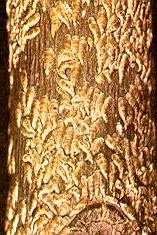 The symptoms are dead material between the leaf veins, along the
leaf edges or dead tips of leaves. There are also times when the
disease affects buds and twigs. In the leaf stage, the disease
only affects leaves currently out. If damage to leaves results
in enough dropped leaves, the tree will shoot another set within
four to six weeks. All they're out is the energy the tree spent
in pushing out another set of leaves. The symptoms are dead material between the leaf veins, along the
leaf edges or dead tips of leaves. There are also times when the
disease affects buds and twigs. In the leaf stage, the disease
only affects leaves currently out. If damage to leaves results
in enough dropped leaves, the tree will shoot another set within
four to six weeks. All they're out is the energy the tree spent
in pushing out another set of leaves.
Of course, we also had a freeze that caused the loss of
leaves on many trees. What I'm getting at is that trees have
spent quite a bit of energy already this year. We need to do
what we can to replace nutrients and keep moisture available.
Moisture will be needed to keep those affected trees in a
vigorous growing condition. Usual watering rates are an inch a
week, and rainfall can supply part or all of that.
Fertilizer applied to lawn area or trees is the other part of
the equation. Fertilizer should be applied at the lawn rate
(supply 1 pound each of nitrogen, phosphorus and potassium per
1,000 square feet of drip area), if you haven't fertilized the
lawn area around the trees. This would translate to about 10
pounds of 10-10-10 fertilizer or 8 pounds of 12-12-12 or
13-13-13 per 1,000 square feet.

Anthracnose is usually the first leaf spot fungus to affect
trees each spring. That means the others can't be far behind.
One the more common ones is apple scab. This disease affects
apples and crab apples in much the same way as anthracnose does
the shade trees. It starts as spots on leaves between the veins
of the leaves and ends with leaves dropping at a rapid rate.
This is the reason for so many "naked" crab apple trees late in
the summer. Traditional spray programs for production apples
(used on the apples or crab apples) should prevent the problem.
Samples of apple scab have been coming in for a week now, so
expect some acceleration of the disease on susceptible
varieties.
[to top of second column]
 |
 Oystershell scale
 It is time to take action against the notorious oystershell
scale, because the eggs are now hatching into young crawlers that
are extremely susceptible to insecticide applications. However, as
the scales mature later in the season, they are more difficult to
control because they form an impenetrable protective covering.
Oystershell scale has a wide host range, including ash, birch,
dogwood, elm, hemlock, maple, poplar, privet, walnut and willow. It is time to take action against the notorious oystershell
scale, because the eggs are now hatching into young crawlers that
are extremely susceptible to insecticide applications. However, as
the scales mature later in the season, they are more difficult to
control because they form an impenetrable protective covering.
Oystershell scale has a wide host range, including ash, birch,
dogwood, elm, hemlock, maple, poplar, privet, walnut and willow.
Eggs hatch into creamy white to brown crawlers that are active
from May through June. The crawlers locate a place to settle and
then use their piercing, sucking mouthparts to remove plant fluids,
which causes leaf yellowing, plant stunting and possibly death.
Branches or twigs totally encrusted with oystershell scale
eventually die.
Insecticides recommended for managing oystershell scale include
acephate (Orthene), bifenthrin, carbaryl (Sevin), malathion,
insecticidal soap and horticultural (summer) oil. All these
insecticides should be applied when the crawlers are most active,
which increases the overall effectiveness in controlling oystershell
scale populations. Repeat applications may be needed 10 to 12 days
later, as the eggs don't all hatch at the same time. Lilacs and
maples should also have a repeat spray in early August.
[Text from file received from
John
Fulton, University of Illinois Extension,
Logan County Unit]
 |